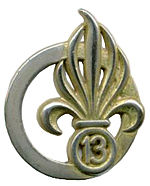13th Foreign Legion Demi-Brigade
| 13th Half-Brigade of the Foreign Legion (13e Demi-Brigade de Légion Étrangère) |
|
|---|---|

Badge of the 13th Foreign Legion Demi-Brigade
|
|
| Active | 20 February 1940 – present |
| Country |
|
| Allegiance |
|
| Branch |
|
| Type | Mechanized Infantry |
| Role | Security Assistance Desert Warfare |
| Size | One battlegroup |
| Part of | Légion Étrangère |
| Garrison/HQ | United Arab Emirates |
| Nickname(s) | The Demi Brigade (English) Phalange Magnifique (Magnificent Phalanx) |
| Motto(s) | More Majorum (after the custom (or manner) of our ancestors) |
| March |
Nos képis blancs (Sous le soleil brulant d'Afrique) |
| Anniversaries | Camerone Day (April 30) and Christmas |
| Engagements |
World War II *Battles of Narvik *Battle of Gabon *Syria-Lebanon Campaign *Battle of Bir Hakeim *Second Battle of El Alamein *Tunisia Campaign *Italian Campaign *Colmar Pocket *Western Allied invasion of Germany First Indochina War *Battle of Hoa Binh *Battle of Dien Bien Phu Algerian War *Operation Jumelles *Global War on Terrorism (2001–present) |
| Commanders | |
| Current commander |
Colonel Nicolas HEUZE |
| Notable commanders |
Raoul Magrin-Vernerey Dimitri Amilakvari Gabriel Brunet de Sairigné Jules Gaucher Bernard Saint-Hillier |
| Insignia | |
| Insignia of the 13 Demi Brigade |  |
| Abbreviation | 13e DBLE |
The 13th Demi-Brigade of Foreign Legion (French: 13e Demi-Brigade de Légion Étrangère, 13e DBLE) is a mechanized infantry demi-brigade of the French Foreign Legion. It is the only permanent demi-brigade in the French Army.
The 13e DBLE was raised in February 1939 at Sidi Bel Abbes in Algeria, with its cadre drawn from 1st Foreign Infantry Regiment (1eR R.E.I). The 13e DBLE fought during World War II for the Free French Forces including service at the Battle of Narvik and the Battle of Bir Hakeim. The unit fought in the French Indochina War and suffered heavy losses at the Battle of Dien Bien Phu.
In January 1940, the British and French high commands had decided to dispatch an expedition to Finland, to support Finnish independence against the Soviet Union in the Winter War. The French decided to allocate a demi-brigade of legionnaires to the expedition – and 13e DBLE was born.
In March 1940, the 13e DBLE comprised 55 officers, 210 non-commissioned officers (sous-officiers), and 1,984 legionnaires. The average age of the legionnaires was between 26 and 28 years old, and most counted 4 to 5 years service. Many of its veteran NCOs had served in the Legion for 10 or more years. The demi-brigade's commander was Raoul Magrin-Vernerey, a hero of World War I, wounded 17 times in battle, who had served with the Legion since 1924 and was Inspector of the Foreign Legion from 1948 to 1950.
...
Wikipedia
